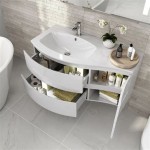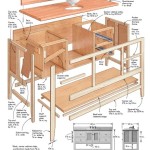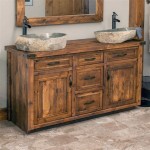Removing A Single-Handle Bathroom Faucet
Replacing a bathroom faucet can significantly improve the aesthetics and functionality of a bathroom. A common type of faucet found in many homes is the single-handle faucet, which controls both water temperature and flow with one lever. While installation is a separate process, the first crucial step is removing the existing faucet. This article provides a comprehensive guide on how to remove a single-handle bathroom faucet, covering necessary tools, preparation steps, and detailed instructions for a safe and efficient removal.
Before commencing the removal process, gathering all the necessary tools is essential. Having the right tools readily available will streamline the task and minimize potential complications. This list represents the core tools needed for most single-handle faucet removals, although specific models might require specialized equipment.
A basin wrench (also known as a faucet wrench) is a long-handled tool specifically designed to reach and loosen the nuts that secure the faucet to the underside of the sink. Due to the confined space under the sink, a standard wrench is often insufficient. Adjustable pliers are useful for gripping and loosening various connection points, such as water supply lines. A set of screwdrivers, both flathead and Phillips head, will be needed to dismantle certain faucet components. Penetrating oil helps to loosen corroded or stuck nuts and bolts. A bucket and towels are crucial for managing any residual water in the pipes and preventing water damage. Safety glasses are essential to protect the eyes from debris or splashes. A flashlight or headlamp will provide much-needed visibility in the often dark and cramped space under the sink. Finally, a plumbing snake or wire is helpful for cleaning out debris in the tailpiece or supply lines.
Prior to any physical work, preparation is paramount to ensure a safe and smooth removal process. This stage involves several critical steps that will prevent water damage, electrical hazards, and potential injuries.
The first and most important step is to shut off the water supply to the faucet. Typically, shut-off valves are located under the sink, one for hot water and one for cold water. Turn both valves clockwise until they are completely closed. If shut-off valves are not present under the sink, the main water supply to the house must be shut off. This is usually located in the basement or near the water meter. After shutting off the water supply, turn on the faucet to relieve any remaining pressure in the pipes. Allow the water to run until it stops completely. Place a bucket under the sink to catch any residual water that may be present in the pipes or faucet. Disconnecting the drain assembly is often necessary to provide better access to the faucet connections. Loosen the slip nuts that connect the drain pipes and carefully remove the drain assembly.
Key Point 1: Disconnecting Water Supply Lines
Once the preparation steps are complete, disconnecting the water supply lines is the next crucial step. The water supply lines connect the shut-off valves to the faucet and must be disconnected before the faucet can be removed. The method for disconnecting these lines can vary depending on the type of connection.
If the water supply lines are flexible hoses connected with compression fittings, use adjustable pliers to loosen the nuts that secure the hoses to the shut-off valves and the faucet. Turn the nuts counterclockwise until they are loose enough to be removed by hand. Have a bucket and towel ready to catch any water that may spill out. If the water supply lines are rigid pipes connected with threaded fittings, use two wrenches – one to hold the shut-off valve and the other to loosen the fitting that connects the pipe to the faucet. This will prevent the shut-off valve from turning and potentially damaging the pipes. If the connections are corroded or stuck, apply penetrating oil to the fittings and let it sit for a few minutes before attempting to loosen them again. In some cases, the water supply lines may be directly connected to the faucet body. These are generally removed in the same manner as flexible hoses, but extra care should be taken to avoid damaging the faucet body. Visually inspect the disconnected supply lines for any signs of corrosion or wear. This is an opportune time to replace the supply lines if necessary, preventing future leaks.
Key Point 2: Loosening the Faucet Mounting Nuts
After disconnecting the water supply lines, the next step involves loosening the faucet mounting nuts. These nuts secure the faucet to the sink from underneath and can be challenging to reach due to the limited space and awkward angles.
The basin wrench is the primary tool used for this task. Place the jaws of the basin wrench around the mounting nut and adjust the head of the wrench to ensure a secure grip. The direction of the ratcheting mechanism may need to be adjusted depending on the direction of the nut. Apply steady pressure and turn the wrench counterclockwise to loosen the nut. Due to corrosion, the nuts can be very difficult to loosen. Applying penetrating oil can help significantly. Spray the nuts with penetrating oil and allow it to sit for at least 15 minutes before attempting to loosen them again. Work slowly and patiently. Avoid applying excessive force, which could damage the faucet, the sink, or the wrench itself. If the nuts are extremely corroded or damaged, consider using a nut splitter to break them apart. Be cautious when using a nut splitter, as it can be aggressive and potentially damage the surrounding area. Once the mounting nuts are loosened, they can usually be unscrewed by hand. Remove the nuts, washers, and any other hardware that secures the faucet to the sink. Keep all the removed parts organized, as they may be needed for reference when installing the new faucet.
Key Point 3: Removing the Faucet from the Sink
With the water supply lines disconnected and the mounting nuts loosened, the final step is to remove the faucet from the sink. This should be a relatively straightforward process, but care should still be taken to avoid damaging the sink or surrounding areas.
Carefully reach under the sink and support the faucet from underneath while simultaneously lifting it from the top. This will prevent the faucet from dropping and potentially damaging the sink. Gently wiggle the faucet back and forth to loosen any remaining seal or adhesive. If the faucet is stuck, use a putty knife or a similar flat tool to carefully break the seal between the faucet base and the sink. Slide the putty knife around the base of the faucet to loosen it. Once the faucet is free, carefully lift it out of the sink. Be mindful of any remaining water or debris that may be trapped under the faucet base. Clean the sink surface thoroughly to remove any old putty, caulk, or other residue. Use a scraper or putty knife to remove the bulk of the material, then use a solvent or cleaner to remove any remaining residue. Inspect the sink for any cracks, chips, or other damage. This is a good opportunity to repair any minor damage before installing the new faucet. Dispose of the old faucet and any associated parts responsibly. Check local regulations for proper disposal methods.
After removing the old faucet, a comprehensive cleaning and inspection of the area beneath the sink is recommended. This stage allows for the identification and resolution of potential issues before the new faucet is installed. Thoroughly clean the sink area using a suitable cleaner to remove any remaining debris, grime, or mildew. Pay particular attention to the area around the faucet hole and the surrounding countertop. Inspect the shut-off valves for any signs of corrosion or leaks. If necessary, replace the valves to ensure proper functionality and prevent future problems. Check the condition of the water supply lines. If they appear worn, corroded, or damaged, replace them with new, high-quality supply lines. This is a proactive measure that can prevent leaks and ensure a reliable water supply to the new facet. Examine the drain assembly for any clogs or damage. Clean out any debris or replace damaged components as needed. Consider applying plumber's putty or silicone sealant around the faucet hole to create a watertight seal when the new faucet is installed. This will prevent water from seeping under the faucet base and causing damage to the countertop or cabinet below.
The process of removing a single-handle bathroom faucet, while seemingly simple, involves several critical steps that must be carefully executed to ensure a successful outcome. This detailed guide provides the knowledge and instructions necessary to complete the task safely and efficiently. By properly preparing the work area, understanding the mechanics of the faucet connections, and utilizing the correct tools, removing an old faucet can be accomplished with confidence and minimal complications. Remember to prioritize safety, take your time, and follow each step meticulously to transform your bathroom with a new faucet. Furthermore, always adhere to local plumbing codes and regulations.

How To Replace Repair A Leaky Moen Cartridge In Bathroom Set Of Faucets Single Lever Tips

Bathroom My Single Handle Faucet Is Leaking Or Dripping

How To Rebuild A Delta Single Handle Faucet

Bathroom Faucet Cartridge Replacement

How To Remove Moen Bathroom Faucet Handle In 2 Steps

How Do I Replace Bathroom Sink Faucet Handles Cleaning More

How To Replace Install Bathroom Sink Faucets Easy Diy Home Upgrade

How To Fix A Leaky Single Handle Sink Faucet

How To Repair A Single Handle Kitchen Faucet Diy Family Handyman

How To Remove A Bathroom Faucet







